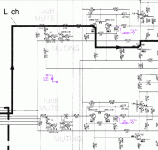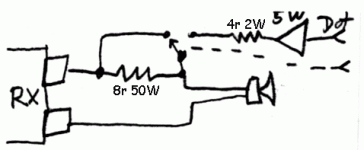I have a old Yamaha RXV995 to which I would like to hook up my Echo Dot. Of course I know I can just use a 3.5mm headphone to L/R RCA cable but this would require constant switching of the input source. It would further be a problem which switched to another input as you would not be able to hear the Echo.
What I propose is to integrate the Echo's signal into whatever the current input is somewhere on the main pre-amp line inside the receiver. I'd like to utilize an existing unused analog input to connect Echo to new modded circuit. I would also like the audio to "cut in" and lower volume of current source while Echo is talking.
I was thinking the easiest way would be to use the main L/R line level outputs on the back of the receiver but this would require a mixer AND a separate amp and I'd like to keep the receiver I have as the amp for main L/R. If I could find exactly where to tap into the main L/R line level channels, I could put a line level mixer in series and send it's output to the mains pre-amp. I'm also wondering if this could all be done internally with minimal additional circuitry.
Just as a side thought, how much harder would it be to do this all digitally? I've seen that the Echo can be modified to send digital audio.
Resources: RX-V995 Service Manual, Echo Dot Digital Conversion
Any input would be greatly appreciated. Thanks!
would be greatly appreciated. Thanks!
What I propose is to integrate the Echo's signal into whatever the current input is somewhere on the main pre-amp line inside the receiver. I'd like to utilize an existing unused analog input to connect Echo to new modded circuit. I would also like the audio to "cut in" and lower volume of current source while Echo is talking.
I was thinking the easiest way would be to use the main L/R line level outputs on the back of the receiver but this would require a mixer AND a separate amp and I'd like to keep the receiver I have as the amp for main L/R. If I could find exactly where to tap into the main L/R line level channels, I could put a line level mixer in series and send it's output to the mains pre-amp. I'm also wondering if this could all be done internally with minimal additional circuitry.
Just as a side thought, how much harder would it be to do this all digitally? I've seen that the Echo can be modified to send digital audio.
Resources: RX-V995 Service Manual, Echo Dot Digital Conversion
Any input
Last edited:
For us old fogies who do not keep up with the latest devices, you might give an overview of what a "Echo Dot" is. In a hasty look, it seems you talk TO Dot. I gather it may talk back?
So what you want is a supermarket speaker system. It plays bouncy music, but when the manager cuts-in to call the mop-boy the music dips.
In such a system you need volume controls for both music and microphone. In _your_ system the music volume will vary. So we can't just mix Dot in before the volume control.
You need a way to know when to turn-down for the voice-over. The market manager's mike has a switch, I assume Dot does not have a "hand" or any simple electric signal(?) to say "I'm talking!". An alternative is a stiff compressor, so a loud voice will "duck" the background music to keep total volume steady. These often sound awkward.
It's my kind of problem. But having figured out one way to do it (hijack the 10dB Mute and feed Dot to the far side of the power amp input), I would not attempt the hack.
So what you want is a supermarket speaker system. It plays bouncy music, but when the manager cuts-in to call the mop-boy the music dips.
In such a system you need volume controls for both music and microphone. In _your_ system the music volume will vary. So we can't just mix Dot in before the volume control.
You need a way to know when to turn-down for the voice-over. The market manager's mike has a switch, I assume Dot does not have a "hand" or any simple electric signal(?) to say "I'm talking!". An alternative is a stiff compressor, so a loud voice will "duck" the background music to keep total volume steady. These often sound awkward.
It's my kind of problem. But having figured out one way to do it (hijack the 10dB Mute and feed Dot to the far side of the power amp input), I would not attempt the hack.
Attachments
Last edited:
Uh, let's think outside the box. (The RX box is too fully packed and too moderately valuable to tinker inside.)
I assume Dot just gives talk-back, not streaming music (since you propose to have her talk-over what is playing).
Give Dot her own 5 Watt amp. Several big resistors and a DPDT relay triggered (somehow) by Dot. Normally the sound flows to the speakers direct. When Dot grabs the mike, the relay and resistors cut the volume of the main sound and inject Dot's sound into a mix.
Dot amp *must* be grounded output (not BTL) so the commons can be commoned with the RX. 5 Watts may even be overkill.
Dot detection would be what we used to call VOX, voice operated relay. Commonly used to bug conversations without rolling tape on silences.
I assume Dot just gives talk-back, not streaming music (since you propose to have her talk-over what is playing).
Give Dot her own 5 Watt amp. Several big resistors and a DPDT relay triggered (somehow) by Dot. Normally the sound flows to the speakers direct. When Dot grabs the mike, the relay and resistors cut the volume of the main sound and inject Dot's sound into a mix.
Dot amp *must* be grounded output (not BTL) so the commons can be commoned with the RX. 5 Watts may even be overkill.
Dot detection would be what we used to call VOX, voice operated relay. Commonly used to bug conversations without rolling tape on silences.
Attachments
Last edited:
The Amazon Echo is what's referred to as a "smart speaker." It responds to voice commands for various tasks such as setting alarms, controlling home automation/lighting, answering questions, telling the weather, etc. It also does streaming audio from many sources such as Pandora, Spotify, Amazon Music, and many more which I do intend to use. The Echo Dot is just a smaller version with a low powered speaker but it does have the 3.5mm jack for line level output as well as Bluetooth output.For us old fogies who do not keep up with the latest devices, you might give an overview of what a "Echo Dot" is. In a hasty look, it seems you talk TO Dot. I gather it may talk back?
So what you want is a supermarket speaker system. It plays bouncy music, but when the manager cuts-in to call the mop-boy the music dips.
In such a system you need volume controls for both music and microphone. In _your_ system the music volume will vary. So we can't just mix Dot in before the volume control.
You need a way to know when to turn-down for the voice-over. The market manager's mike has a switch, I assume Dot does not have a "hand" or any simple electric signal(?) to say "I'm talking!". An alternative is a stiff compressor, so a loud voice will "duck" the background music to keep total volume steady. These often sound awkward.
Yes. This sounds like what I'm looking for. Although there's no signal dedicated to this purpose, an LED does illuminate when the Echo is talking but not when it's just playing music. Perhaps a light sensor could be placed over it and utilized for this "hand" signal.
It's worth noting that the Echo has it's own volume control which would help in achieving the proper volume balance between the two sources. I'm starting to think it may be be easier to integrate a Bluetooth receiver to which the Echo, or any other device, could connect to.
Another consideration is the difference between the two desired "modes" of operation.
- Echo selected as the active input. This would be for when Echo is used to play music. No ducking needs to occur, just pass the input through to the amplifier like any other.
- Something else selected as the active input. This is where the voice commands and responses would need to duck the current source until the output stops, which as I said above, could probably be done with a light sensor.
It's my kind of problem. But having figured out one way to do it (hijack the 10dB Mute and feed Dot to the far side of the power amp input), I would not attempt the hack.
Am I correct in assuming you would not because of the complexity and density of the of the components on the board? I've had it apart before and it's quite a bit larger than some PC motherboard circuitry I've worked on. I'm just not very familiar with analog circuits which is why I'm here.
You gave me exactly what I was looking for in the two points where the signal need be inserted. I'd just like to talk about it a bit more and come up with the best solution. I'll respond to your second email separately.
Uh, let's think outside the box. (The RX box is too fully packed and too moderately valuable to tinker inside.)
I assume Dot just gives talk-back, not streaming music (since you propose to have her talk-over what is playing).
Give Dot her own 5 Watt amp. Several big resistors and a DPDT relay triggered (somehow) by Dot. Normally the sound flows to the speakers direct. When Dot grabs the mike, the relay and resistors cut the volume of the main sound and inject Dot's sound into a mix.
Dot amp *must* be grounded output (not BTL) so the commons can be commoned with the RX. 5 Watts may even be overkill.
Dot detection would be what we used to call VOX, voice operated relay. Commonly used to bug conversations without rolling tape on silences.
This is an interesting way to do it but as I stated in my previous reply, I would actually be using it for music. This would not provide adequate sound quality for my purposes unless I used a bigger amp. If I were to go that route I may as well just keep it all external, take the main line level out to a mixer, mix it with the echo, then to the 2nd amp and power the main L/R speakers separately. It would take some fiddling to get the levels right where they used to be and it probably would never sound the same.
I'm leaning more towards sacrificing one of the analog inputs which are mostly unused anyway and connect where you previously mentioned. Then I would be able to connect anything to it in the future.
Are there any other pitfalls other than the possibility of damaging nearby traces and components?
- Status
- This old topic is closed. If you want to reopen this topic, contact a moderator using the "Report Post" button.

